This year, one of the major sections of Il Cinema Ritrovato (29 June - 6 July 2013) is War is near: 1938-1939. The festival organisation did not make the most obvious choices for the section, but selected "films which captivate fear and frail hopes, random shadows, inconclusive dialogues, everything that the greatest films around that period, such as Renoir's La Règle du jeu, did so miraculously". One of these films is Paradis perdu/Paradise Lost (1939), directed by Abel Gance and starring Elvire Popesco (1894-1993), a French actress of Romanian origin. In the twenties she went to Paris, where she conquered the stages with her comic talent and heavy accent. In the thirties she became a popular film star, who worked with such great directors as Julien Duvivier, Sacha Guitry, Marc Allégret, and of course Abel Gance.

French postcard by EC, no. 41.
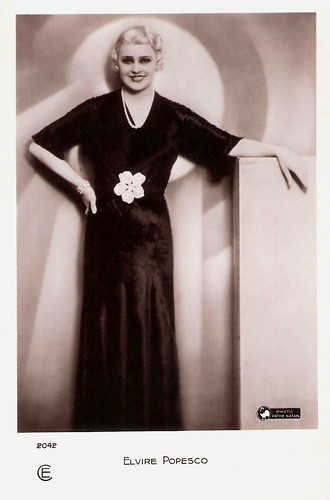
French postcard by CE (Cinemagazine-Selection), Paris, no. 2042. Photo: Pathé Natan.

French postcard by EC, no. 41. Photo: Studio Piaz, Paris.
Artistic Director
Elvire Popesco was born Elvira Popescu in Bucharest, Romania in 1894. She started to perform at the Teatrul Naţional (Bucharest national theatre) after a training at the Conservatorul de Artă Dramatică din Bucureşti (Bucharest Conservatory for Drama). She played a small part in the Romanian silent film Independenta Romaniei/The War for Independence (Aristide Demetriade, 1912), inspired by the war between Romania and the Ottoman Empire. It was the first Romanian feature film to last for nearly two hours (from which are about 20 minutes lost now). Seven years later Elvira became the artistic director of the Excelsior Theatre (1919) and subsequently of the Teatrul Mic (1921). Then she played in the film Tigancusa de la iatac/The girl of the garret (Alfred Halm, 1923). French playwright Louis Verneuil convinced her to go to Paris. Around 1924 she rose to stardom at the Parisian stages because of her comic talent and her heavy accent. She was Verneuil's favourite actress in the later 1920s and early 1930s. He first cast her in Ma cousine de Varsovie (1923). In 1931 she would also play in the film version of this play, directed by the Italian director Carmine Gallone. Actually, from the start of sound cinema in France, Popesco had a growing prolific career there, culminating in nine film parts in 1938-1939. She worked with a wide range of directors, a.o. four times with Pierre Colombier (including Tricoche et Cacolet/Tricoche and Cacolet, 1938), but also with Julien Duvivier (L'Homme du jour/The Man of the Hour, 1936), Abel Gance (Paradis perdu/Paradise Lost, 1939), Sacha Guitry (Ils étaient neuf célibataires/Nine Bachelors, 1939), and Marc Allégret (Parade en sept nuits/Parade in 7 Nights, 1940). Her co-stars in those years were men like Maurice Chevalier, Louis Jouvet, Erich von Stroheim, Fernandel, and Henri Garat.

French postcard by A.N., Paris, no. 64.
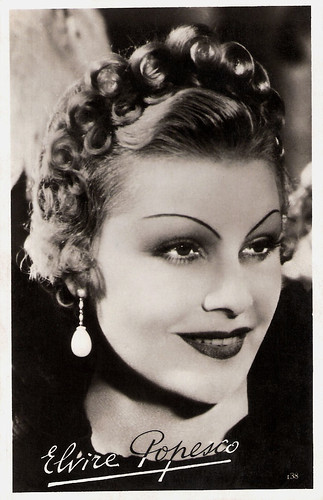
French postcard by Editions et Publications Cinématographiques, no. 138.
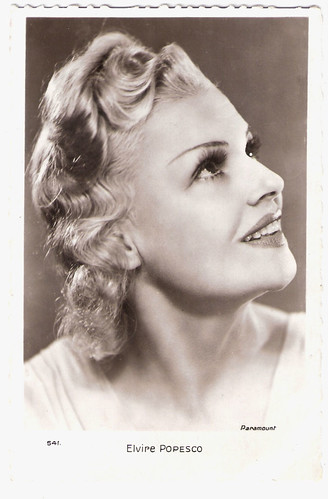
French postcard by Ed. Chantal, Paris, no. 541. Photo: Paramount.
A Big Stage Come-back
In the first war years Elvire Popesco continued to play in films like Mademoiselle Swing (Richard Pottier, 1941) with Jean Murat and Irène de Trebert. Presumably this affected her career because only in 1948 she could make a big stage come-back with Tovaritch by Jacques Deval, which was retaken with Popesco in 1960. After that Popesco had again an active stage career, playing for instance in three pieces by André Roussin: Nina (1949), La voyante (1963-1964), and La Mamma (1957-1958, 1974); the latter was purposefully written for her by Roussin. She also performed in La machine infernale by Jean Cocteau (1953). From 1953 to 1965 she was director of the Théàtre de Paris and subsequently of the Théàtre de Marigny (1965-1978). In 1959 Popesco returned to the cinema and played her last film parts in Plein soleil/Purple Noon (René Clement, 1960) starring Alain Delon, and as Napoleon's mother in Austerlitz/The Battle of Austerlitz (Abel Gance, 1960). After she had married the count Maximilien Sebastien Foy (her third husband), Popesco kept a well-frequented salon in Mézy-sur-Seine (Yvelines). From 1930 to 1985 she lived there in a modernist-style villa, owned before by fashion designer Paul Poiret, and remodelled in 1932 by architect Paul Boyer. Together with Anna de Noailles, Marthe Bibesco and Elena Vacarescu, Popesco seems to have been Henri Matisse's inspiration for his La blouse roumaine (1940). In 1987 Popesco was awarded a Molière d’honneur for her entire career, and in 1989 president François Mitterrand made her a Commandeur de la Légion d'honneur. Elvire Popesco died in 1993 in Paris at the age of 99. She lies buried at the Cimetière du Père-Lachaise in Paris. She was married to comedian Aurel Athanasescu with whom she had a daughter, Tatiana; to politician Ion Manolescu-Stronga (Minister of Industry and Commerce), and to count Maximilien Sebastien Foy.
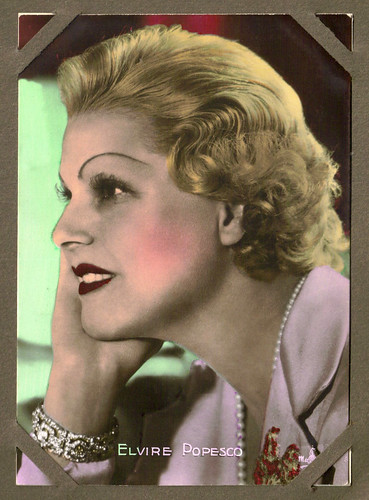
French card by Massilia. Collection: Amit Benyovits.

French postcard. Photo: Filmsonor.
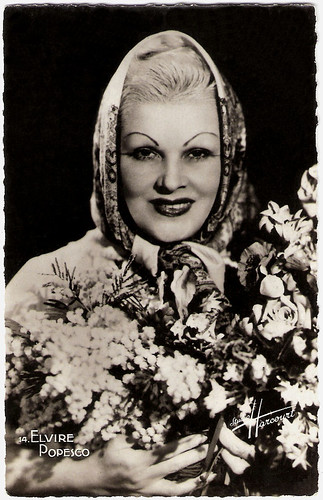
French postcard by S.E.R.P., no. 14. Photo: Studio Harcourt.
Sources: Caroline Hanotte (CinéArtistes), Wikipedia, and IMDb.

French postcard by EC, no. 41.

French postcard by CE (Cinemagazine-Selection), Paris, no. 2042. Photo: Pathé Natan.

French postcard by EC, no. 41. Photo: Studio Piaz, Paris.
Artistic Director
Elvire Popesco was born Elvira Popescu in Bucharest, Romania in 1894. She started to perform at the Teatrul Naţional (Bucharest national theatre) after a training at the Conservatorul de Artă Dramatică din Bucureşti (Bucharest Conservatory for Drama). She played a small part in the Romanian silent film Independenta Romaniei/The War for Independence (Aristide Demetriade, 1912), inspired by the war between Romania and the Ottoman Empire. It was the first Romanian feature film to last for nearly two hours (from which are about 20 minutes lost now). Seven years later Elvira became the artistic director of the Excelsior Theatre (1919) and subsequently of the Teatrul Mic (1921). Then she played in the film Tigancusa de la iatac/The girl of the garret (Alfred Halm, 1923). French playwright Louis Verneuil convinced her to go to Paris. Around 1924 she rose to stardom at the Parisian stages because of her comic talent and her heavy accent. She was Verneuil's favourite actress in the later 1920s and early 1930s. He first cast her in Ma cousine de Varsovie (1923). In 1931 she would also play in the film version of this play, directed by the Italian director Carmine Gallone. Actually, from the start of sound cinema in France, Popesco had a growing prolific career there, culminating in nine film parts in 1938-1939. She worked with a wide range of directors, a.o. four times with Pierre Colombier (including Tricoche et Cacolet/Tricoche and Cacolet, 1938), but also with Julien Duvivier (L'Homme du jour/The Man of the Hour, 1936), Abel Gance (Paradis perdu/Paradise Lost, 1939), Sacha Guitry (Ils étaient neuf célibataires/Nine Bachelors, 1939), and Marc Allégret (Parade en sept nuits/Parade in 7 Nights, 1940). Her co-stars in those years were men like Maurice Chevalier, Louis Jouvet, Erich von Stroheim, Fernandel, and Henri Garat.

French postcard by A.N., Paris, no. 64.

French postcard by Editions et Publications Cinématographiques, no. 138.

French postcard by Ed. Chantal, Paris, no. 541. Photo: Paramount.
A Big Stage Come-back
In the first war years Elvire Popesco continued to play in films like Mademoiselle Swing (Richard Pottier, 1941) with Jean Murat and Irène de Trebert. Presumably this affected her career because only in 1948 she could make a big stage come-back with Tovaritch by Jacques Deval, which was retaken with Popesco in 1960. After that Popesco had again an active stage career, playing for instance in three pieces by André Roussin: Nina (1949), La voyante (1963-1964), and La Mamma (1957-1958, 1974); the latter was purposefully written for her by Roussin. She also performed in La machine infernale by Jean Cocteau (1953). From 1953 to 1965 she was director of the Théàtre de Paris and subsequently of the Théàtre de Marigny (1965-1978). In 1959 Popesco returned to the cinema and played her last film parts in Plein soleil/Purple Noon (René Clement, 1960) starring Alain Delon, and as Napoleon's mother in Austerlitz/The Battle of Austerlitz (Abel Gance, 1960). After she had married the count Maximilien Sebastien Foy (her third husband), Popesco kept a well-frequented salon in Mézy-sur-Seine (Yvelines). From 1930 to 1985 she lived there in a modernist-style villa, owned before by fashion designer Paul Poiret, and remodelled in 1932 by architect Paul Boyer. Together with Anna de Noailles, Marthe Bibesco and Elena Vacarescu, Popesco seems to have been Henri Matisse's inspiration for his La blouse roumaine (1940). In 1987 Popesco was awarded a Molière d’honneur for her entire career, and in 1989 president François Mitterrand made her a Commandeur de la Légion d'honneur. Elvire Popesco died in 1993 in Paris at the age of 99. She lies buried at the Cimetière du Père-Lachaise in Paris. She was married to comedian Aurel Athanasescu with whom she had a daughter, Tatiana; to politician Ion Manolescu-Stronga (Minister of Industry and Commerce), and to count Maximilien Sebastien Foy.

French card by Massilia. Collection: Amit Benyovits.

French postcard. Photo: Filmsonor.

French postcard by S.E.R.P., no. 14. Photo: Studio Harcourt.
Sources: Caroline Hanotte (CinéArtistes), Wikipedia, and IMDb.
2 comments:
Fascinating life, in film, on stage and to have inspired Matisse, too. Great video clip. Something so animated and expansive about actors who emerged from the early film era. Happy PFF.
She looks like she'd be fun to take a walk or have a drink with!
Post a Comment